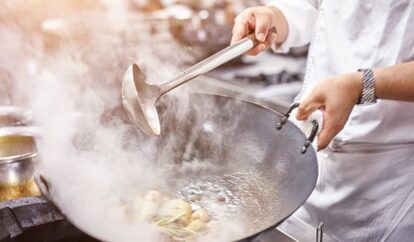You know how to price your Chinese restaurant menu, but designing it has you stumped.
“What Chinese dishes do I include?”
“How should I lay out my menu?”
“How many menu items should I have?”
“Should I hire a designer or do it myself?”
“What colors are best?”
“Which font should I choose?”
The good news is that creating your Chinese restaurant menu isn’t difficult. In fact, it’s pretty easy – follow these four steps to create your menu the right way.
Step 1: Choose whether (or not) to outsource the creation of your Chinese restaurant menu.
Step 2: Create your Chinese restaurant menu according to menu design best practices.
Step 3: Become an expert in Chinese cuisine by acquainting yourself with top Chinese dishes.
Step 4: Draw inspiration for your design from effective chinese restaurant menus online.
Ready? Let’s get started.
Step 1: Outsource the Creation of Your Chinese Restaurant Menu
You can outsource the menu design to a graphic designer or agency, or create it yourself using menu design software. While your financial situation and design skills will play a significant role in your final decision, it pays to understand exactly what you’re getting yourself into. Let’s look at the options.
Option 1: Agency
While it may be the most expensive of your options, an agency is also the most inclusive, since they normally handle the whole design process, including printing. Agencies are generally best for larger restaurant chains who have big budgets, so if you’re a new restaurant owner, a freelance designer may just give you the best bang for your buck.
Option 2: Graphic designer
The cost of a freelance graphic designer falls somewhere between hiring an agency and doing it yourself. You’ll want to hire someone who not only has a high skill level, eye for design, and takes direction well, but ideally they’ll also know about menu design best practices and menu psychology.
One disadvantage of hiring a designer is that you lack control over the designs. Each time there’s a menu change, you’ll have to contact your designer and pay them for the changes – whether it’s a redesign or just a small tweak.
But how do I hire the right designer?
Start by doing one or all of the following:
- Speak to your restaurant consultant for credible referrals
- Display a job posting online or in your local newspaper
- Contact other restaurant owners that have menus you admire and ask for a referral
- Chat with your staff and ask for references
- Use a design association:
Once you have a few names, whittle down your list and start the interview process. Make sure you ask open-ended questions and assess the personality traits of your designer. For further tips on hiring the best talent, check out our hiring guide.
Option 3: Menu Design Software
The most cost-effective option for the average restaurant, Menu Design Software lets anyone create a personalized menu. Choose a design you like from the library of professionally-designed templates, then customize it to fit your brand and your menu. Don’t worry if you’re not a designer – this software does all of the heavy lifting.
Pros:
- This software is the most affordable option for restaurants.
- You have final say on how your menu looks.
- No need to wait for a designer. You can make updates and print anytime.
- No design skills necessary. Layouts, matching fonts and colors, item sections have already been designed for you.
- Some of the solutions, like MustHaveMenus, offer restaurant-specific templates for flyers, social media, and more to round out your marketing.
Cons:
- It can be time-intensive to search through the templates and customize one with all your menu info.
Here are the two best menu design software options:
- $12.95 per month
- Restaurant-focused
- The largest library of menu templates on the web
- Editing software that’s designed specifically for menu creation
- Additional marketing materials like punch cards, flyers, and social media posts
- Professional Printing
- $15 per month
- Restaurant-focused
- Large collection of menu templates
- No real-time customer service
- No professional printing
Step 2: Create Your Chinese Restaurant Menu
Once you’ve completed step one, it’s time to get started with your design. The design of your Chinese restaurant menu should be based on menu design best practices. These will include everything from format, length, and layout to branding, photos, and choice of color.
Understand that even if you have a designer or agency handling the design, it pays to understand the best practices so you can gauge whether they’re on track, pinpoint what you like/don’t like, and explain why.
Chances are also good that your agency or designer will likely miss one or two essential elements. If this happens, you’ll be able to step in and take control. Besides, there’s something empowering about knowing what’s going on, right?
Let’s look at all these best practices.
Format options
Here are four formats to consider:
- Single page menus are best suited if you plan to have a small number of dishes you update often.
- Two-panel, single-fold menus are a standard format in the restaurant industry. This format lets diners read the menu over two pages, allows for a more extensive variety of dishes, and gives you more room to strategically place certain dishes.
- Three panel, two-fold menus are perfect for family-style restaurants. While ideal for displaying a broad variety of dishes, too many options may actually make it harder for your diners to make a choice.
- Panel booklet will allow you to display the greatest variety of dishes. While this format may be appealing for some, it won’t be for everyone.
Ultimately the format you choose will depend on the style of your Chinese restaurant, how often you plan to update your menu, and the number of dishes you want.
Menu length
Even if you choose to have a long menu and format, consider starting the design process by thinking small. Create a small menu, gather feedback from your customers, and then add or remove menu items as required.
Pro tip: Build your menu around the standard paper size of 8.5″ x 11″. If your menu takes up more than
12″ x 18″, try making different menus for different categories (e.g. wines and desserts).
Number of dishes
While your restaurant concept may dictate that you have a large variety of dishes, menu engineers suggest limiting the menu options to no more than seven options per food category.
The reasoning is based on psychology theory. It’s the Paradox of Choice: too much choice causes anxiety and makes deciding much harder. And, when faced with too many dish choices, diners will likely end up selecting a dish they know. If that dish is a low-margin one, your profits will suffer.
Menu layout
Here are three menu layout options:
- Order: Organize your menu according to how diners order: appetizers, mains, desserts.
- Category: Create subcategories such as noodles and salads.
- Columns and Rows: Use columns to arrange dishes in a category and rows to separate items (see our discussion on fonts for the importance of whitespace).
Pro tip:Engineer your menu to boost profits by organizing it based on where the eye falls. When reading a menu, diners eyes start in the middle, then move to the top right, and then top left (Golden Triangle). Include high-margin dishes in this prime real estate.
Branding
Branding includes both naming and menu descriptions, and these should align with your brand. For example, if your brand is quirky and fun, use words aligned with that personality or tone.
Naming your Chinese dishes
Here are five strategies you can use to name your dishes (with Chinese examples):
- Main ingredient: swordfish, duck, or prawns
- Sensory appeal: savory, sweet, crispy pork, tender, spicy, sumptuous, sticky rice
- Geography: Chinese, Zhejiang cuisine, Cantonese cuisine, Anhui cuisine
- Nostalgia: classic, homemade, authentic
- Cooking method: Stir-frying, braising, stewing, boiling, steaming
Take note: Naming dishes may include a combination of methods, like “authentic Cantonese cuisine” (nostalgia and geography).
Describing your Chinese restaurant menu items
The shorter your descriptions, the better. Here are the key elements to include:
- Mention the main ingredient.
- List a few ingredients, but be specific (e.g. jasmine-scented rice instead of just rice).
- Describe the cooking process.
- Create enticing descriptions for high-margin dishes by appealing to the senses.
- Indicate which dishes are most popular.
Photos
Chefs, diners, and restaurateurs have different views on whether or not to use photos. Some argue that images are synonymous with cheap restaurants and that they can detract from the dining experience. Is it any surprise that high-end restaurants don’t use them?
That being said, photos are a great way to capture the diner’s eye and, used in moderation, can increase your sales. Plus, research suggests that using just one photo per page can boost profits by up to 30%.
So, the verdict is in: if you want to use photos, use them sparingly and ensure you hire a food photographer to take stunning photos.
Color
Like photos, colors are an eye-magnet. Color strengthens your brand and restaurant concept, helps diners group information based on visual cues (e.g. red may indicate a different menu category from the rest) and activates different associations in the mind of diners.
- Green signifies freshness
- Orange raises appetite levels
- Red drives action
- Yellow draws attention
Fonts
When choosing the right font for your menu, consider the following:
- Your font must be easy to read. Consider printing a sample and testing it with your staff and even your target market if you’re unsure.
- Any font should reinforce your brand. For example, a plain font will work for a casual restaurant.
- Certain fonts are better for online menus versus print menus and vice versa. For example, Serif fonts work well for print and Sans serif for digital.
- Don’t have more than three fonts, but do use them consistently. For example, having a different font for each main dishes looks tacky.
- Bold menu items to guide the reader to profitable dishes.
Background
Keep your background simple, something that doesn’t make the menu cluttered or hard to read. Keep text to a bare minimum and break up sections with white space.
Listing menu prices
How should you list prices on your menu? Here are four options:
- $5.99
- $5
- 5
- Five
An increasing amount of restaurant owners are choosing option three because it creates a cleaner menu. A recent study also shows that having no dollar signs can actually increase sales.
Calorie labeling
The final thing you’ll have to consider is calorie labeling laws and whether it will impact your menu design. In some regions of Canada and the US, new calorie labeling laws mean you have to add calorie information to your menu if you’re part of a chain of 20+ restaurants.
Step 3: Become an Expert in Chinese Cuisine
Chinese dishes generally have two things: carb or starch (like noodles and rice) and accompanying dishes of vegetables, fish, and meat. Lots of fresh vegetables such as mushrooms and chestnuts are standard.
While you may expect certain dishes on any Chinese restaurant menu – such as sweet and sour pork, wontons, chow mein, Peking roasted duck, and even spring rolls – Chinese cuisine is incredibly diverse. It differs in ingredients, flavor, and cooking styles depending on the region. For example, wheat-based dishes are like noodles are popular in the North, but in the South it’s rice.
But, of course, we can dig even deeper than only comparing the North and South. There are eight notable cooking traditions: Cantonese, Sichuan, Anhui, Shandong, Fujian, Jiangsu, Hunan, and Zhejiang. Let’s explore these and some top Chinese dishes for each region.
1. Cantonese
Dim sum – dumplings that contain a filling – is a standard Cantonese dish and can be made through steaming, frying, stewing, or even baking. The Cantonese will often combine eating dim-sum with drinking tea – a tradition known as yum cha.
2. Sichuan
Sichuan cuisine is known for its bold flavors and spiciness, thanks to the generous use of garlic and chili peppers. Other common ingredients are peanuts, sesame, paste, and ginger. Some traditional Sichuan dishes include:
- Kung pao chicken or spicy diced chicken, made by frying diced chicken, dry red pepper, and golden peanuts
- Sichuan hot pot, usually with a chili pepper-flavored broth and meat: duck, chicken breast, beef tripe, and kidneys
- Dandan noodles, covered in chili oil, together with vegetables, pepper, and minced pork on top
3. Jiangsu
Braising and stewing are the two preferred cooking methods here. Some typical Jiangsu dishes are
salted dried duck, crystal meat (pork heels cooked in brown sauce), Yangzhou steamed Jerky strips (ingredients include dried tofu, chicken, ham and pea leaves), and sweet and sour mandarin fish.
4. Anhui
Anhui cuisine is similar to Jiangsu cuisine, but the focus is more on using local ingredients such as herbs, bamboo shoots, mushrooms, and vegetables. Two traditional Anhui dishes are:
- Bamboo shoots, sausage, and dried mushrooms
- Salted Mandarin fish: locally caught fish, marinated in salt brine, and braised in bamboo shoots
5. Shandong
Shandong cuisine features many cooking methods, and dishes are usually fresh, salty, crisp, and tender. Authentic dishes you might include on your menu are braised abalone, sweet and sour carp, and Dezhou chicken.
6. Fujian
Influenced by its coastal positions and mountains, Fujian cuisine is very diverse. Fresh ingredients such as bamboo shoots and mushrooms are typical.
Most dishes are served in a broth and soup, and one of the most famous – Buddha Jumps Over the Wall – combines a whopping 30-plus ingredients and takes three days to make.
7. Hunan
Hunan cuisine uses a large variety of ingredients and is famous for being spicy, aromatic and colorful. Common cooking techniques include stewing, braising, smoking, and pot roasting. Here are some top Hunan dishes:
- Shredded pork served with fresh peppers
- Boiled yellow catfish
- Steamed ribs prepared with black beans and chili pepper
- Braised eel and cucumber
8. Zhejiang
Zhejiang cuisine is synonymous with fresh, subtle flavors and gentle fragrances. There are typically three styles of Zhejiang cooking:
- Hangzhou style, with common dishes including soups, stir-fries, and seafood
- Shaoxing style, which focuses on freshwater and poultry
- Ningbo style, which specializes in seafood and confectionaries
Step 4: Find Inspiration from Chinese Restaurant Menus
Now that you’ve worked your way through steps one to three, it’s time to get inspired with examples of good menu design. While examples below include Chinese restaurant menus, we’ve also provided menus that aren’t. After all, inspiration can come from anywhere, right?
1. Peking Gourmet Inn – Falls Church, Virginia
Peking Gourmet has a clean menu that uses red to separate categories and stimulate appetite. See how they also call out their specialty, Peking duck?
2. R & G Lounge – San Francisco, California
Concept-based menu design helps you tell your restaurants story. R & G Lounge’s menu is built on the Five Elements Theory, regarded as the cornerstone of the Chinese culture.
3. The Sinclair – Cambridge, Massachusetts
Under Consideration – Sinclair. Designed by Oat Creative.
Here is a simple and clean menu that makes it easy for your diners to navigate.
4. Eleven Madison Park – New York City, New York
Under Consideration – Eleven Madison Park. Designed by Juliette Cezzar.
Here’s a minimal grid design. Again, a perfect example of a simple menu.
5. Chick-a-Biddy – Atlanta, Georgia
Under Consideration – Chick-A-Biddy. Designed by Tad Carpenter.
Chick-a-Biddy provides inspiration and ideas on how to incorporate color into their menu. They’ve strategically used yellow to stimulate appetite appeal.
6. A Single Pebble – Burlington, Vermont
Menus can also create nostalgia. At A Single Pebble “dining is discovery. Each dish carries its own history; each bite brings the essential flavors of China to your table.”
7. Smoke & Duck Sauce – Atlanta, Georgia
Smoke & Duck Sauce thought out-the-box with this menu design. You’re able to fold these menus up into beautiful origami cranes.
8. Quo Vadis – London, UK
This menu keeps things straightforward, and the clever use of boxes makes it easy to call-out specific dishes.
9. Matamata – Paris, France
Under Consideration – Matamata. Designed by Content Design Lab.
With this grid layout, implementing the golden triangle is a breeze.
10. La Principal – Bogotá, Colombia
Under Consideration – La Principal. Designed by Arutza Rico Onzaga.
As La Principal shows, when done correctly, photos can strengthen your menu.
Conclusion
Creating your Chinese restaurant menu doesn’t need to be a struggle. All you have to do is make sure you follow the four simple steps outlined:
- Decide who will create your menu
- Base the design on solid menu design principles
- Acquaint yourself with Chinese cuisine
- Find examples of good menu design online
Follow the steps and you’ll be that much closer to having the perfect menu and, with it, a thriving Chinese restaurant!





